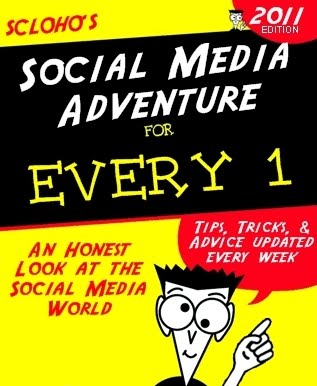
by Scott Howard | Nov 28, 2011 | ScLoHo's Web World
First off, there is a big difference between Scheduling and Automating your Social Media updates.
I’m going to spend a few days exploring this subject, feel free to chime in.
In 2003 and 2004 I started and stopped a couple of blogs. It wasn’t a priority for me and the software platform I was using didn’t offer the ability to write something and publish it at a future date.
Then a few years later, I decided I was going to take this more seriously and writing blog posts became as regular as brushing my teeth.
I have all my teeth.
And yet I don’t brush them at the exact same time every day.
When I went from 2 to 3 to 4 separate blogs, I needed a plan. So I created one. Between the 4 blogs I was doing 46 updates a week, and this was a sideline, not my full time profession. On Collective Wisdom I had updates at 6am, noon, and 6pm. On the Really? blog I updated at 6am and 4pm. This was 7 days a week. Another blog was updated weekly, and the 4th was updated 5 days a week.
Maybe if this was my only job, and I had no family to consider and never wanted to take time off, this could have been done without scheduling.
But I scheduled. I would write a few blog posts in one sitting. I would write when I had the time for future dates. And I always had to write at least one of those updates in the morning for that evening, due to the nature of the subject.
But wait, these are blog posts, they aren’t social media, some of you say.
Wrong.
These blog posts were a way to spread the word about ______________ and I always left the door open to comments and conversations.
Now that I’m using WordPress instead of Blogger and I’ve changed my habits with this website to a 5/5/5 plan (see more info in the footer of this website), I always schedule ahead of time.
Do you schedule? Why or Why not?
Tomorrow, I’ll dig deeper into this subject and the topic will focus on Twitter.

by Scott Howard | Nov 24, 2011 | ScLoHo's Web World
From Mediapost:
5 Tips For Stepping Into Social Media
by Martin Bishop
Back when I worked in marketing, the closest I ever got to customers were focus groups. From the safety of a darkened, M&M-stocked backroom with a one-way mirror, I was able to listen to what they said about my brand and whatever new line extension or ad campaign we were testing. I never had to actually talk to them.
These days, social media offers marketers the opportunity to get much more up close and personal with their customers. Although that prospect should be attractive, marketers seem to be having a lot of trouble adapting. A quick scan of Twitter and Facebook shows the many ways in which marketers don’t get it. There are the abandoned accounts where marketers have just given up and there are others where marketers are plowing on even though they are doing more harm than good.
I offer up five social media tips that may help:
1. Be human
When you’re using social media, you are stepping into the room with your customers and you need to engage with them on a personal level. If you want them to stick around, you need to behave appropriately. That means you need to be empathetic, generous, interesting and interested and capable of having a conversation about your brand without bragging, spamming or talking like you are a press release. In any social media interaction, you should be asking yourself: What would a human do? And do that.
2. Don’t overreach
Difficult as it may be to accept, it’s likely that your consumers don’t like you all that much. Some of the brands that are recognized social media stars—Starbucks, Coke, Zappos—do have passionate fans and have used social media to build even deeper and stronger relationships with them. But most brands aren’t so lucky and won’t be able to copy what they do and hope for the same success. If you have a relatively weak relationship, your customers are going to quickly tire of you if you are all Chatty Cathy with them. A study by ExactTarget showed that the #1 reason for people to unlike brands on Facebook was that they posted too frequently.
3. Add value
Rather than try and force conversations that your customers don’t want to have, think about how to add some value. Even brands in the most mundane of categories with the weakest of relationships can find ways to add value. For example, they can provide useful information about their products and about their product category. Or take up an important cause. If all else fails, a sure-fire way of adding value is to give out coupons (which is what most consumers want anyway).
4. Listen and respond
Here’s an astonishing stat. According to a study by Socialbakers, brands don’t respond to 95% of questions posted on their Facebook walls. 95%! If you’ve gone to all the trouble of setting up a page, it seems almost perverse not to bother responding to customer questions. This is a two-way medium. You get to talk but you also need to listen and respond.
5. Use the tools yourself
Here’s another astonishing stat. A recent IBM study of 1,700 CMOs found that 82% planned to increase their use of social media. However, only 26% of them are actually tracking blogs and less than half are tracking consumer reviews to help shape their marketing plans. Not good enough! Start using the tools and learn by participation. It’s really not that difficult.
Anything else to add to the list?

by Scott Howard | Nov 23, 2011 | ScLoHo's Web World
My co-worker, Kevin Mullett does a LOT of speaking engagements.
One topic he talks about is measuring the right things, and that was one of my reasons for joining Kevin at Cirrus ABS and working in the web world of marketing instead of the broadcast world where most of my career was previously.
7 years ago, I didn’t measure the results of my online activity. I didn’t know what to look for and I was experimenting anyway. I was writing a couple of blogs and the results were not important to me at the time.
But when you are using your online presence as a part of your marketing or as the hub of your business, you should consider measuring the results.
Because the web tracks what you and others do, it is one of the easiest marketing platforms to track.
The downside is all that you are getting is a bunch of numbers, stats and sometimes worthless information unless you know what to look for in all this data.
And most folks don’t.
They don’t know what to look for, so they don’t look.
Or if they do look, they don’t connect the dots.
To be truthful, there is no “one and only” way to do this.
There are lot’s of ways to attempt to do it which falls short.
Seth Godin wrote about but I disagree with parts of what he says is important.
Instead, I see lot’s of problems with people analyzing the data and tracking a customer to the final transaction, which can be done if you know how.
And I’m not just referring to e-commerce sites.
Before you even start your next social media campaign or launch your next website, let’s talk.
We’ll dig deep and discover what your goals are and why.
We’ll ask the tough questions and determine the options for reaching those goals along with the costs in time and money.
And we will stick with you and help you measure all the important stuff, the stuff that matters to your success. It’s not a cookie cutter approach.
Contact me on on the contact page of this website and we’ll begin.

by Scott Howard | Nov 16, 2011 | ScLoHo's Web World
Storytime.
This is a story about starting a blog or two a few years ago then hopping on Twitter in 2008 without knowing for sure what the outcome would be.
I’m going to refer to some folks by their Twitter handle because Twitter was instrumental in this story.
2003, I started a blog after watching my kids Rachael @greenglasshero , Josh @gandhizero and Tiffany @phanniejay start blogs.
All four of us stopped blogging but the next year I launched two blogs, one a personal site, and the other a work related site.
ScLoHo’s Really was the personal site now featuring a Fort Wayne area website of the day every morning to promote the city I live in, and then an update every afternoon, with what ever I want to feature. Saturday nights I featured a Classic Music Video.
ScLoHo’s Collective Wisdom featured information on Marketing, Media, Advertising and Sales; was updated 3 times a day, 7 days a week, which sounds pretty industrious, but the concept is that every article features Wisdom from others (that’s where the Collective comes from), with a few words of introduction or commentary from me.
My wife suggested I write a book on Marketing, but instead I simply started another site, The Not-So-Secret Writings of ScLoHo. The self-imposed rule was that the words are all mine, which separates it from Collective Wisdom. This blog-site was updated weekly.
Then at the end of 2010, I contemplated, planned and launched one more blog-site, ScLoHo’s Social Media Adventure which was updated 5 days a week at noon.
During all of this time, I never received any significant financial reward for all of this activity. My paying gig was working for a group of local radio stations as a sales person and manager.
The past few years I have been invited to give presentations, seminars, been interviewed and have written articles about marketing and even spoke to a college class a few times about Social Media & Branding.
All of this was simply a creative outlet for me. There was no master plan except I needed a way to share ideas that I felt passionate about.
At the end of 2008 I started a Twitter account and after playing around with it, made some connections both locally and worldwide which have now opened doors.
Chad Pollitt @CPollittIU and Amy Stark @AmyStark who both have ties/roots to Fort Wayne were there in my beginning Twitter Days and then Kevin Mullett @KMullett became a friend who I grew to respect.
In January 2011, Kevin revived the Fort Wayne Social Media Breakfast @SMBFW and asked me to be one of the panelist along with Heather Schoegler @HSchoegler; Lee Hershberger @LeePings; and Randy Clark @RandyClarkTKO .
I had known Heather for a couple years and Lee & Randy for a few months, but this was the first time I met Lee & Randy face to face.
Fast forward to April 21, 2011.
Randy Clark, who is in Indianapolis, invited various social media friends to a monthly gathering in Indy for the past couple of months and I planned my regular radio station sales rep life to be in Indy for business during the day and meet with Randy and friends that evening for what is now called a FriendUp.
At the meeting at the downtown Scotty’s Brewhouse @BrewHouse we are eating fried pickles and other goodies and the 5 of us are all answering the question Randy asks, “What do you need/want & how can we help each other?”
I decided to go last and listen to what the others were saying.
My answer was that I would like to explore leaving the radio world and earn my living in the social media or web world, but I was not willing to leave Fort Wayne. That evening was my 8th anniversary at the radio stations, and with the exception of a couple of the air staff, I have been there longer than anyone else.
Everyone’s “wish list” was complied in an email, then posted on a private website, so others who had attended Randy’s previous FriendUps could join in.
Kevin Mullett saw what I said and contacted me with the message, “We need to talk”.
Kevin has done multiple things over the years and his current title is Director of Product Development for Cirrus ABS @CirrusABS . And so we had lunch.
Which lead to more questions on my part so we had lunch again.
It was after this second lunch where I learned more precisely what Kevin had in mind and I went from curious to excited about the possibility of changing employers and direction with my career.
A week later, I met with Matt Nickols, the founder of Cirrus ABS over lunch and was offered a position with his company.
June 1st, another meeting, (this time without food!) to discuss details, review a formal offer and accept with a start date of June 20, 2011.
What struck me was, there was no formal application process, no resume I gave them, no job posting that I saw anywhere, this was all due to the accumulation of my 7+ years of social media involvement, and the connections that I made via Twitter.
But it wasn’t just the connections, it was the relationships that were built.
My returning to the world of radio advertising in 2003 was sort of a default.
My real passion is to help businesses (and people) connect and be successful with what I know about marketing, advertising, sales and a bit of psychology.
In other words, build meaningful, profitable relationships.
Since radio was my chosen “fall back career” since I was a teenager, that’s why I’ve worked in that arena the past 8 years.
Now I use my passions with a new, growing media with a strong leader in all things web related and continue to help businesses (and people) connect and be successful.
My thanks to all that I’ve mentioned and many others too.
Shortly after joining Cirrus ABS this year, I decided to reorganize my various blogging activities into one website and launched this site officially on October 3rd, 2011.
You can continue to contact me at Scott@ScLoHo.net.
And recently for those of you who prefer to follow along on Tumblr, I am now feeding updates to my Tumblr account here.


by Scott Howard | Nov 15, 2011 | ScLoHo's Web World
As I look at my Twitter stream I see a variety of conversations and announcements going all day and night. Most are from individuals but some are from Brands.
(You can apply this to Facebook, but I’m going to talk in Twitter terms.)
What’s a Brand?
For this discussion, let’s say a Brand is a company account that is not identifiable as an individual. @CBSNews would be an example. As would @CirrusABS.
The challenge for a Brand is to become someone or something that people want to follow.
MarketingProfs has some ideas to share:
Is Your Content Too Focused?
Any SEO strategy hinges on offering relevant, valuable information. But that might not mean what you think it does.
According to the Todaymade blog, we content marketers gravitate toward discussions of our core businesses. “But the challenge that we all have in marketing is moving past those spheres of immediate influence to some of the more expanded topics that our customers really care about,” they note.
To illustrate their point, Todaymade uses the example of Joe, an independent retailer who sells shoes and athletic goods. He has a competent website that lists his products and includes friendly touches like photos of his employees.
Customers rarely use the site to make purchases, however, and Joe only keeps it going because businesses in 2011 are supposed to have websites. He has a Facebook page for the same reason, and receives only a smattering of likes when he posts new content every week or so. As far as Joe can tell, his online presence has a negligible impact on sales.
“But what would happen if Joe started expanding his core?” Todaymade asks. The key to increased response for Joe, they say, is to stop talking exclusively about his products, and start talking about how his products are used. He could, for instance, blog about:
- Favorite running spots
- Current running and training techniques
- Options for monitoring heart rates and measuring distances
And his social media strategy could include:
- Mapping out jogging paths
- Organizing group runs
- Supporting athletic events
By expanding beyond his content core, Joe could create a thriving online presence that generates trust and—importantly—ranks well.
The Po!nt: Put yourself in their shoes. When you produce content, instead of just talking about your products, expand your message to express how your readers are using them in the real world.
Source: Todaymade.





